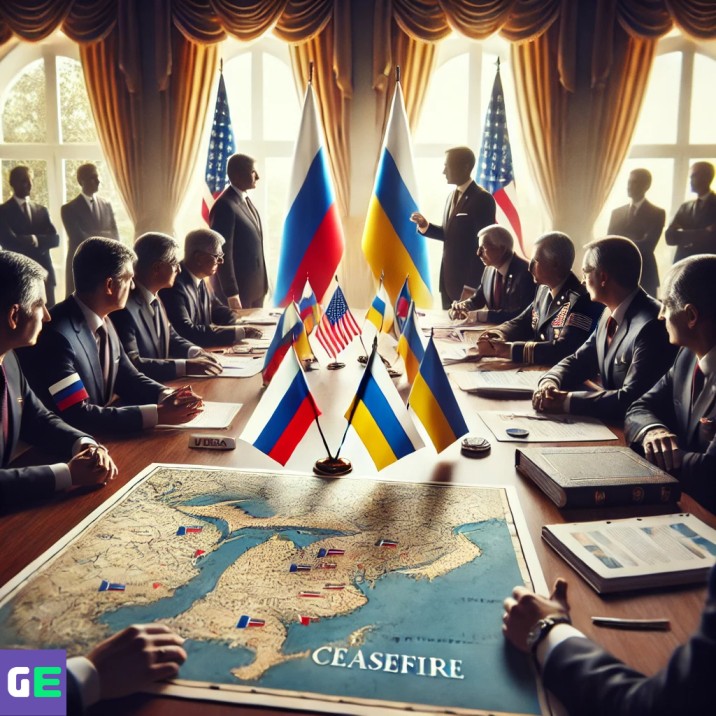Introduction
The war between Russia and Ukraine has significantly shaped global politics, with the United States playing a key role in supporting Ukraine both financially and militarily. Amidst ongoing conflicts, Putin ceasefire conditions have emerged as a pivotal point of discussion in diplomatic circles. As world leaders weigh the possibility of negotiations, it is crucial to understand how these conditions could impact U.S. foreign policy.
In this blog, we will break down Putin ceasefire conditions, analyze the U.S. response, and explore the broader consequences for global stability. For American policymakers, strategists, and the general public, this issue is more than just international news—it directly affects U.S. interests, economic policies, and national security.
1. What Are Putin’s Ceasefire Conditions?
To understand the implications for U.S. foreign policy, we must first examine what Putin ceasefire conditions entail. Over the past two years, Russia has put forward various demands as prerequisites for halting military operations. These conditions generally include:
1.1 Recognition of Russian-Occupied Territories
One of the core Putin ceasefire conditions is for Ukraine and Western nations to recognize Russian sovereignty over the territories Moscow has annexed, including Crimea, Donetsk, Luhansk, Kherson, and Zaporizhzhia. This demand directly challenges international law and U.S. support for Ukraine’s territorial integrity.
1.2 Ukraine’s Neutrality and NATO Non-Membership
Another critical condition is Ukraine’s official neutrality, meaning it would abandon any aspirations to join NATO or the European Union. For the United States, this condition contradicts long-standing commitments to NATO expansion and global security.
1.3 Lifting of Economic Sanctions
Russia has repeatedly demanded the lifting of Western sanctions as part of the Putin ceasefire conditions. These sanctions, imposed by the U.S. and its allies, have significantly impacted Russia’s economy and are seen as a tool to pressure Moscow into diplomatic resolutions.
1.4 Demilitarization of Ukraine
Russia has called for the reduction of Ukraine’s military capabilities, ensuring it cannot pose a threat to Russian interests. This condition directly conflicts with the billions of dollars in military aid the U.S. has provided to Ukraine.
These conditions reflect Russia’s broader strategic objectives and highlight the stark differences in geopolitical interests between Moscow and Washington.
2. How the U.S. Views Putin’s Ceasefire Conditions
The United States has been one of Ukraine’s strongest allies in the war, providing military aid, intelligence support, and diplomatic backing. Thus, the Biden administration and U.S. policymakers have expressed skepticism regarding Putin ceasefire conditions, viewing them as a strategic maneuver rather than a genuine effort for peace.
2.1 Rejection of Territorial Concessions
The U.S. has consistently stated that any ceasefire deal that involves Ukraine ceding territory to Russia is unacceptable. Allowing Russia to keep occupied regions could set a dangerous precedent for future territorial aggression.
2.2 NATO’s Role in the Conflict
Since the beginning of the war, NATO has expanded its military presence in Eastern Europe. If Ukraine remains neutral as per Putin ceasefire conditions, it could weaken NATO’s influence in the region, something U.S. policymakers want to avoid.
2.3 Maintaining Economic Pressure on Russia
Lifting economic sanctions would ease financial strain on Moscow and allow Russia to rebuild its war-torn economy. The U.S. is unlikely to support this condition without significant Russian concessions.
2.4 Concern Over Russia’s Trustworthiness
U.S. intelligence agencies and analysts have warned that Russia may use a ceasefire as an opportunity to regroup and launch further attacks in the future. The 2014 annexation of Crimea serves as a historical example of why U.S. officials remain cautious about any ceasefire negotiations.
3. Impact on U.S. Foreign Policy
3.1 Diplomatic Strategy Shift
If the U.S. accepts certain Putin ceasefire conditions, it could signal a shift in diplomatic strategy. The U.S. might have to negotiate directly with Russia, balancing military deterrence with diplomatic efforts.
3.2 U.S.-Ukraine Relations
A ceasefire agreement could affect the strong partnership between the U.S. and Ukraine. If the U.S. pushes Ukraine to accept unfavorable conditions, it could weaken trust between the two nations.
3.3 Impact on Military Aid and Defense Spending
Should a ceasefire be implemented, U.S. military aid to Ukraine may decrease, altering defense spending priorities. This could lead to political debates in Washington regarding the allocation of resources for European security versus domestic needs.
3.4 Broader Implications for NATO and Global Alliances
A U.S. stance on Putin ceasefire conditions will influence its relationships with NATO allies. If Washington takes a softer approach, European nations may need to reassess their security strategies.
4. Potential Consequences for Global Stability
4.1 Risks of a Temporary Truce
A ceasefire that aligns with Putin ceasefire conditions could be a temporary pause rather than a lasting peace. History suggests that Russia could use the break to strengthen its military before resuming hostilities.
4.2 Effect on U.S.-China Relations
China has positioned itself as a neutral party in the conflict, calling for peace talks. If the U.S. rejects Russia’s ceasefire terms, it could complicate relations with Beijing, which may see an opportunity to expand its influence.
4.3 Economic Implications
The war has contributed to rising energy prices and global economic instability. A ceasefire, depending on its terms, could either stabilize or further disrupt markets. The U.S. will need to navigate these economic challenges carefully.
5. Expert Opinions & Analysis
5.1 Political Analysts’ Perspectives
Experts in international relations suggest that Putin ceasefire conditions are a strategic move to solidify Russia’s territorial gains while testing Western unity.
5.2 Military Experts’ Insights
Defense analysts warn that if Russia is allowed to dictate the terms of a ceasefire, it may embolden future territorial ambitions, not just in Ukraine but in other former Soviet territories.
5.3 Economic Forecasts
Economists argue that lifting sanctions prematurely could give Russia the financial strength to continue aggressive foreign policies, making economic deterrence a key discussion point.
6. What Comes Next for the U.S. and the World?
As discussions around Putin ceasefire conditions continue, the U.S. must carefully evaluate its response. Several possible scenarios could unfold:
- Diplomatic Engagement – The U.S. and its allies may push for a ceasefire that does not compromise Ukraine’s sovereignty.
- Continued Military Support – If the ceasefire terms are deemed unacceptable, the U.S. might increase military aid to Ukraine.
- Hybrid Approach – A combination of diplomacy, economic sanctions, and strategic military support could be pursued.
Conclusion
The debate over Putin ceasefire conditions highlights the complex nature of international diplomacy. For the United States, any response to these conditions must balance national security, economic stability, and global leadership.
As policymakers continue to assess the situation, staying informed is crucial for American citizens, businesses, and investors. The war’s outcome will have long-term implications for U.S. foreign relations, global stability, and economic policies.
Would you like updates on this developing situation? Follow our blog for the latest insights on U.S. foreign policy and global affairs Read more
FAQs
1. What Are Putin Ceasefire Conditions and Why Are They Controversial?
Putin ceasefire conditions refer to the specific terms and demands set by Russia for ending hostilities in the ongoing war with Ukraine. These conditions typically include recognizing Russian-occupied territories, ensuring Ukraine’s neutrality, lifting economic sanctions, and reducing Ukraine’s military capabilities.
The controversy arises because these demands are seen as heavily favoring Russia, undermining Ukraine’s sovereignty, and challenging international law. The U.S. and its allies have largely rejected these conditions, arguing that they would legitimize Russian aggression and weaken global security norms. Many experts believe that accepting Putin ceasefire conditions without significant Russian concessions would set a dangerous precedent for future conflicts.
2. How Have the United States and NATO Responded to Putin Ceasefire Conditions?
The United States and NATO have taken a firm stance against Putin ceasefire conditions, emphasizing that any peace agreement must respect Ukraine’s territorial integrity. U.S. officials have repeatedly stated that accepting Russia’s terms would amount to rewarding aggression.
NATO, in particular, has increased military aid to Ukraine in response to Russia’s demands. The alliance views Putin ceasefire conditions as an attempt to weaken Western influence in Eastern Europe and prevent Ukraine from aligning with the West. By rejecting Russia’s terms, the U.S. and NATO aim to maintain global stability and deter future acts of aggression by authoritarian regimes.
3. Could Putin Ceasefire Conditions Lead to a Lasting Peace?
While Putin ceasefire conditions are presented as a path to peace, many analysts argue that they may only provide a temporary pause in hostilities rather than a long-term resolution. Historically, Russia has used ceasefires as strategic pauses to regroup and strengthen its military position.
For a lasting peace, both sides must agree to terms that do not compromise Ukraine’s sovereignty or security. The U.S. insists that peace must come through negotiations where Ukraine has equal standing, rather than through one-sided demands imposed by Moscow. If Putin ceasefire conditions do not offer real security guarantees, they are unlikely to bring lasting stability to the region.
4. How Do Putin Ceasefire Conditions Impact U.S. Foreign Policy?
The United States plays a crucial role in shaping global diplomatic efforts, and Putin ceasefire conditions directly impact U.S. foreign policy. Accepting Russia’s demands could signal weakness and embolden other aggressive nations, whereas rejecting them reinforces America’s commitment to international law and democratic values.
Additionally, U.S. foreign policy must balance military support for Ukraine with diplomatic efforts to prevent further escalation. By rejecting Putin ceasefire conditions, the U.S. continues to provide military and economic assistance to Ukraine while working with allies to impose further sanctions on Russia. The broader impact is a shift in U.S. diplomatic strategy, with increased focus on deterring authoritarian expansionism worldwide.
5. How Would Accepting Putin Ceasefire Conditions Affect Global Security?
If Putin ceasefire conditions were accepted without significant compromises from Russia, it could set a dangerous precedent for international relations. Other nations might view it as a signal that aggression leads to territorial gains, potentially increasing instability in other regions.
For instance, China could see this as encouragement to assert its claims over Taiwan, or other conflicts in the Middle East and Africa could escalate due to perceived Western weakness. The United States and its allies fear that compromising with Russia could weaken global security alliances and embolden other authoritarian leaders.
By rejecting Putin ceasefire conditions, the U.S. seeks to reinforce the principle that territorial sovereignty and international law must be upheld to maintain long-term global stability.
6. How Do Economic Sanctions Relate to Putin Ceasefire Conditions?
One of the most significant Putin ceasefire conditions is the demand to lift Western economic sanctions imposed on Russia. These sanctions have severely impacted Russia’s economy by restricting its access to global markets, cutting off major financial institutions, and reducing revenue from energy exports.
The U.S. and European allies argue that lifting sanctions without meaningful Russian concessions would undermine their economic pressure strategy. The Biden administration has stated that any discussion about lifting sanctions must be tied to real, verifiable steps toward peace, including the withdrawal of Russian troops from occupied territories.
If Putin ceasefire conditions were accepted without addressing these concerns, it could allow Russia to rebuild its military strength and continue its aggressive policies in the future.
7. What Are the Risks of a U.S.-Russia Ceasefire Deal Based on Putin Ceasefire Conditions?
A ceasefire agreement based on Putin ceasefire conditions poses several risks for the United States. First, it could weaken America’s credibility as a global leader in upholding democratic values and international law. If the U.S. agrees to Russia’s terms, other nations may question its commitment to defending allies in future conflicts.
Second, accepting these conditions could divide NATO, as some European allies might support a deal while others reject it. A fractured alliance could reduce Western influence and give Russia more leverage in global negotiations.
Finally, a rushed ceasefire agreement might allow Russia to consolidate its territorial gains, regroup, and launch future offensives when it sees an advantage. This would make the conflict more prolonged rather than resolving it.
8. How Are Putin Ceasefire Conditions Being Received by Ukraine?
Ukraine has firmly rejected Putin ceasefire conditions, viewing them as a direct violation of its sovereignty and territorial integrity. President Volodymyr Zelensky has repeatedly stated that Ukraine will not accept any peace agreement that requires ceding land to Russia.
Ukraine argues that accepting Putin ceasefire conditions would only reward Russian aggression and lead to further escalations in the future. Instead, Kyiv insists that any ceasefire must come with security guarantees backed by Western nations to prevent future invasions.
The U.S. has echoed Ukraine’s concerns, supporting a peace process that respects Ukraine’s independence rather than forcing it to accept unfavorable terms dictated by Moscow.
9. Could China Influence Putin Ceasefire Conditions?
China has positioned itself as a potential mediator in the Russia-Ukraine war, but its stance on Putin ceasefire conditions remains ambiguous. While Beijing has called for peace talks, it has not condemned Russia’s invasion outright, leading many to believe it supports Moscow’s broader strategic goals.
If China chooses to pressure Russia into softening Putin ceasefire conditions, it could play a significant role in ending the conflict. However, if Beijing aligns with Moscow’s demands, it may encourage a geopolitical shift where authoritarian nations challenge Western leadership.
For the U.S., China’s involvement in ceasefire negotiations presents both risks and opportunities. On one hand, diplomatic engagement with China could lead to a more balanced agreement. On the other, a China-Russia alliance could create new challenges for U.S. foreign policy in Asia and beyond.
10. What Is the Future of U.S. Policy If Putin Ceasefire Conditions Are Rejected?
If the United States continues to reject Putin ceasefire conditions, its long-term policy will likely focus on strengthening Ukraine’s defense, increasing economic sanctions on Russia, and reinforcing NATO’s presence in Eastern Europe.
Additionally, the U.S. may push for diplomatic negotiations that do not solely rely on Russia’s demands but instead include international guarantees for Ukraine’s security. These efforts would aim to create a fairer, more sustainable peace agreement rather than one dictated by Russia’s military gains.
While rejecting Putin ceasefire conditions could prolong the war in the short term, the U.S. and its allies believe that a firm stance now will prevent greater conflicts in the future. The ultimate goal is to establish a global order where aggression does not go unpunished and diplomatic solutions are based on mutual respect for sovereignty.












Leave a Reply